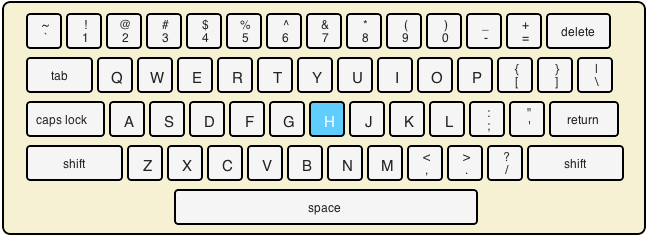The predictive keyboard in QuickBrownFrog has gone through three major iterations so far. At first, I really didn’t expect to be able to implement a functional keyboard in GWT (i.e. Javascript+CSS), so I set about drawing the keyboard using Omnigraffle.
Round 1 - Static Images
It was fairly easy to whip up the initial design. But then in order to implement key selection I had to create about 100 variations of this with all the different keys selected. That was painful.
GWT provides a way to bundle image resources, and that helped keep the image size in check, but it was still a bit slow on the client until all the images were cached. Unfortunately this also meant that I had to create a mongo ImageResources.java interface, which listed every foo_key() foo_keyShifted(), etc.
So this clearly wasn’t optimal, but it worked for a while. Then when I decided it was time to change the “selected” color, and I had to manually re-color every single PNG. Obviously, this was not going to scale, and it was time to re-think my approach. So I set about experimenting with ways to programmatically generate the keyboard.
Round 2 - SVG
First up, I went with SVG. The SVG Canvas is not natively supported in every browser, but the GWT-Graphics library gracefully uses VML in Internet Explorer, making it effectively cross-platform. This worked pretty well, and after a day and a half tweaking the layout, I had a functional SVG keyboard. And finally I was able to change the look of the keys (color, shape, etc) very easily with a couple lines of code. I was thrilled!
Unfortunately VML on IE was still kind of slow, and also had some occasional rendering problems. Still, this was far better than a huge set of static images, so I stuck with SVG for a while. When it came time to re-design the website with a new color scheme I was really thrilled to not have to update 100+ keyboard images in Omnigraffle again.!
Round 3 - CSS
With launch-time approaching, the speed issues with VML have really started to become a problem. Clearly, a predictive keyboard needs to be faster than the typist using it, and my keyboard was not keeping up. That led me to my third iteration- CSS.
Since my SVGKeyboard.java was created as an AbsolutePanel subclass, it was fairly straightforward to re-implement it in regular old GWT. Instead of an SVG rect, each key is now simply an AbsolutePanel, with InlineLabels for keycaps.
Implementing the “selected” coloring is as simple as adding and removing a CSS style that specifies the color and background-color. I was even able to make the keys look rounded with the following bit of CSS magic:
-moz-border-radius: 4px;
border-radius: 4px;
It’s perhaps not as pretty as my original Omnigraffle drawing, but that seems a small sacrifice to make for ease of maintenance, should I decide to tweak the design in the future. Plus there’s the performance improvement- typing really flies now!


